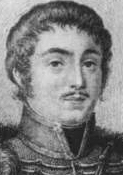General Claude Étienne Guyot

Born: September 5, 1768
Place of Birth: Villevieux, Jura, France
Died: November 28, 1837
Place of Death: Paris, France
Arc de Triomphe: GUYOT, C. on the west pillar
Pronunciation:
Claude Étienne Guyot first joined the cavalry in November of 1790 when he joined the chasseurs à cheval of Brittany. In 1792 he served in the Army of the Rhine, and the next year he was commissioned as a sous-lieutenant and he joined the Army of the Moselle. After a brief stint in the Vendée in 1794, Guyot served in Italy in 1796. In 1797 he received a promotion to lieutenant and then in 1799 he was with the Army of Germany when he was promoted to capitaine.
In 1802 Captain Guyot officially joined the Chasseurs à Cheval of the Consular Guard. In 1804 he was promoted to chef d'escadron and he went on to take part actively in the campaigns that followed over the next few years. In 1805 he served at Austerlitz and in 1807 he served at Eylau. After Eylau, he was promoted to colonel in the guard.
In 1808 Guyot became a Baron of the Empire and a Knight of the Iron Crown, and he also followed Napoleon to Spain, leading a detachment of chasseurs. After his superior General Lefebvre-Desnouettes was captured by the British, Guyot assumed unofficial command of the 2nd Chasseurs à Cheval. However, Napoleon proclaimed that the command of that regiment would be vacant until Lefebvre-Desnouettes' return, and so Guyot never received the official title.1 Guyot and the chasseurs followed Napoleon on to the Danube campaign of 1809, and they took part in the Battle of Wagram . A month after the battle he was promoted to général de brigade.
1810 saw General Guyot honored as a chamberlain to the emperor and in 1811 he returned to Spain, became a Commander of the Legion of Honor, and was promoted to général de division. During 1812 Guyot led the chasseurs of the Imperial Guard throughout the Russian campaign and retreat. Guyot was quite busy in 1813, fighting and being wounded at Lützen before then serving at Bautzen. Next he became a Count of the Empire and he was taken prisoner at Kulm in late August but then exchanged. He fought at the Battle of Leipzig that October and after General Walther died suddenly he took Walther's place in charge of Grenadiers à Cheval of the Imperial Guard.
Guyot continued to serve into 1814, fighting at Brienne, La Rothière, Champaubert , Montereau , Craonne, and Reims. After Napoleon's abdication he was named a Knight of Saint Louis and was placed with the Royal Cuirassiers, but he rejoined Napoleon in 1815 on Napoleon's return from exile on Elba. Napoleon gave Guyot command of a division of heavy cavalry of the Imperial Guard, and Guyot led them into action at Waterloo, where he was wounded by two shots. He served briefly in the Army of the Loire afterwards and then retired in 1816. Guyot returned to military service in August of 1830 to command the 10th military division and then retired again in October of 1833.
Notes
Bibliography
- Haythornthwaite, Philip J. Who Was Who in the Napoleonic Wars. London: Arms & Armour, 1998.
- Senior, Terry J. "The Top Twenty French Cavalry Commanders". Accessed 2005. http://www.napoleon-series.org/research/commanders/c_twenty.html
- Six, Georges. Dictionnaire Biographique des Généraux & Amiraux Français de la Révolution et de l'Empire (1792-1814). 2 vols. Paris: Gaston Saffroy, 2003.
External Links:
Updated April 2025
© Nathan D. Jensen